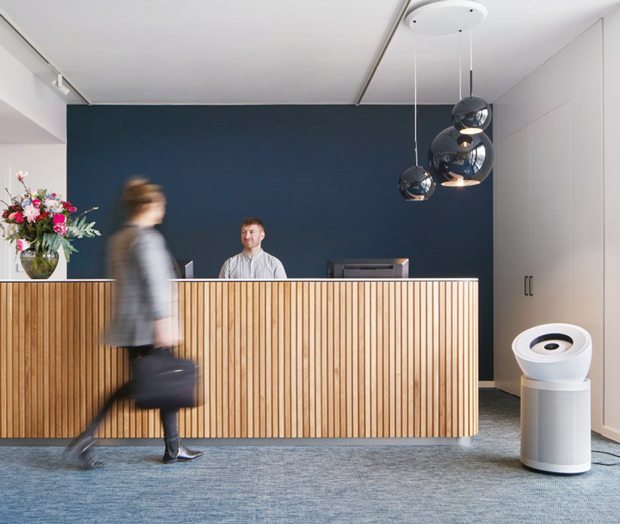The design experts at Dyson on the latest innovations in lighting and ventilation to help support wellbeing at work
We know that prioritising wellness and mental health has become paramount for businesses. Recognising the importance of fostering a happy, healthy, and supportive work environment is encouraging companies to place increased emphasis on these aspects. This strategic focus not only contributes to employee satisfaction but also plays a significant role in talent retention and attraction. Acknowledging that individuals have diverse needs and perceptions regarding wellness and mental health requires employers to remain adaptable to meet their varied requirements effectively.
CREATING THE RIGHT LIGHTING FOR YOUR WORKSPACE
Lighting is a key component of our daily lives and something we encounter almost everywhere we go – from workspaces and transport hubs to education settings and in our home. As businesses continue to navigate high energy costs, they are always looking for ways to reduce energy consumption across the whole building. Lighting choices play a key role in this.
Natural Lighting: For FMs, bringing the outside in to create a feel of relaxation, productivity, and creativity remains a key priority. In many workplaces, lighting can feel clinical with a ‘one size fits all’ approach which creates strain on the eyes. Each worker is individual and has individual needs, and by creating bespoke lighting options in individual workspaces, a user can adjust the lighting to suit their specific needs.
Motion activated lighting: Many buildings are now equipped with motion activated lighting, reducing costs, improving energy efficiency and avoiding unnecessary usage. These offer FMs the flexibility to turn off lights remotely at the touch of a button adding an additional level of peace of mind.
Reducing time spent changing light bulbs: Changing light bulbs regularly takes time, investment and organisation. Fluorescent lighting can be inefficient, waste light and use costly-to-replace bulbs, while LEDs can suffer from overheating, affecting their longevity and brightness. Without proper cooling, LED bulbs can quickly overheat causing fading and discolouring. Choose lighting that uses Heat Pipe technology that effectively cools the LED and protects the light quality as well as enable the user to reliably adjust colour and brightness without flickering bulbs and outages.
AIR PURIFICATION TECHNOLOGIES IMPROVE WELLBEING
With people spending up to 90 per cent of their time indoors, the impact of poor indoor air quality is a universal concern that affects everyone, and in particular office workers. Dyson’s Air Purity Pulse Check found that 90 per cent of the UK public say that air quality in the workplace is important. Pollutants or Volatile Organic Compounds (VOCs) are emitted from numerous sources including fuels, flooring, cleaning products, and even soft furnishings. These micro pollutants are impossible to see but can have an impact on our health, wellbeing and productivity.
With 90 per cent of companies planning to implement return-to-office policies by the end of 2024, these shared spaces face challenges related to a potential increase in airborne pollutants. Short-term exposure to poor air quality indoors can lead to various negative effects on health and wellbeing. Workers may experience heightened fatigue, difficulty concentrating, and an overall sense of discomfort. Those with respiratory conditions such as asthma may notice an exacerbation of symptoms, including coughing and shortness of breath. Additionally, poor indoor air quality can contribute to the spread of viruses and respiratory infections.
Studies show that 61 per cent of urban offices reported levels of air pollution above the WHO guidelines for safe indoor air quality. This data underscores the critical importance of proactively embracing available solutions for air purification in buildings. This should not be seen as a seasonal measure but rather as a year-round necessity. Indoor air quality also influences employee attitudes to their workplace, with two thirds (66 per cent) of the UK public saying they would be uncomfortable working somewhere with poor air quality.
By exploring a range of air purification technologies, it is possible to address risks associated with poor indoor air quality, ensuring that occupants thrive in an environment conducive to both health and productivity. This collaborative effort between building owners and facilities managers holds the potential to create a working environment that prioritises the health and wellbeing of all.






